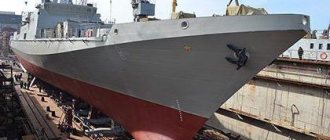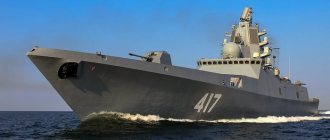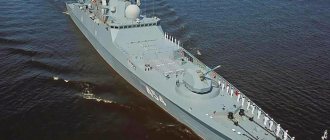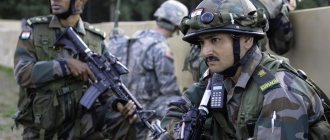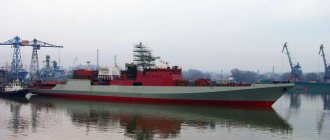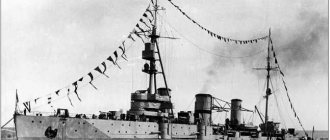India - to refuse: The frigate "Admiral Butakov", contrary to plans, was urgently sent to Crimea
There is reason to believe that Moscow has taken the recently announced US and NATO plans to dramatically increase their military presence in the Black Sea very seriously. And it takes retaliatory measures of an almost emergency nature in advance. The leadership of the Russian Ministry of Defense has decided to urgently increase our naval group in Sevastopol, even to the detriment of other Russian fleets.
This, oddly enough, does not follow from official reports from the highest authorities of the Russian Federation. And from a completely ordinary, seemingly newspaper interview with a naval commander of a relatively low rank - the commander of the 30th division of surface ships of the Black Sea Fleet, Rear Admiral Oleg Krivorog . This formation, which forms the basis of the combat power of the Black Sea Fleet, recently celebrated its anniversary. On this occasion, Rear Admiral Krivorog began to talk about plans to strengthen his division. And among other things, he suddenly said this: “We are expecting the commissioning of the fourth frigate, Admiral Butakov. Its crew is now being formed.”
Why is this worth paying special attention to? Here we should at least briefly recall the very difficult history of the construction of the mentioned ship in Kaliningrad, which will be armed with high-precision cruise missiles "Caliber-NK".
Missing "Admirals". What happened to the frigates of Project 11356R?
10 years ago, active construction of the lead frigate of Project 11356R began at the Baltic Shipbuilding Plant located in Kaliningrad (part of the United Shipbuilding Corporation, USC).
At that time, no one imagined what serious problems the implementation of this program would result in in the near future and what losses the Russian Navy would suffer.
Heir to "Petrel"
The history of the 11356R project must begin with the fact that this series is distinguished by a pronounced Soviet pedigree. This type of frigate has many similarities with the guard ships of Project 1135 “Burevestnik” and Project 11351 “Nereus”, in the construction of which the ship was widely involved during the Cold War.
The accumulated competencies made it possible to develop Project 11356/11356A for the Indian Navy in the late 1990s. In 1999-2013, six such ships were built for the needs of New Delhi: Talwar (“Sword”), Trishul (“Trident”), Tabar (“Axe”), Teg (“Sabre”), Tarkash (“Quiver”) and Trikand ("Bow").
This success did not go unnoticed in Moscow. In 2010-2011, the Russian Ministry of Defense entered into contracts with shipbuilders to launch an improved series for the domestic Navy with fairly broad integration of technology to reduce radar signature and underwater noise.
It was assumed that Project 11356R with a well-developed production cycle would support the deteriorating fleet of ships of the 1st and 2nd ranks and allow Russia to demonstrate the pennant in the near and far sea zones until mass production of more modern frigates and corvettes with missile weapons was established. The relatively modest construction cost per unit was also tempting - about 13 billion rubles.
The displacement of the Project 11356R ship is about 4 thousand tons, length - 124.4 meters, width - 15.2 meters, draft - 4.2 meters, mission range - 4.8 thousand miles, endurance - 30 days, speed - 30 knots (55 km/h), crew - 180 people.
The Kalibr-NK missile system, a 100-mm A-190 Universal artillery gun, two twin DTA-53-11356-2 torpedo tubes, and one RBU-6000 bomb launcher were chosen as strike weapons. The air defense systems on the Project 11356R ship are represented by the Shtil anti-aircraft complex and the AK-630 30-mm artillery mount.
The Ministry of Defense expected that the new ships would be part of the Black Sea and Baltic fleets. After the annexation of Crimea, it was decided to transfer all platforms of the Black Sea Fleet.
However, 2014 adjusted not only these plans. Due to the sanctions imposed by Ukraine, Yantar managed to build only three frigates: Admiral Essen, Admiral Grigorovich and Admiral Makarov.
Russia literally jumped into the last car, having managed to purchase and receive gas turbine units from the Zorya-Mashproekt enterprise (Nikolaev).
At the same time, at the time of the breakdown in military-technical cooperation between the two countries, three ships were laid down: “Admiral Butakov”, “Admiral Istomin” and “Admiral Kornilov”.
In 2015, at the naval show in St. Petersburg, the Commander-in-Chief of the Russian Navy, Viktor Chirkov, announced that “the Russian fleet will abandon the last three ships of this project.”
However, in the same year, the Ministry of Industry and Trade of the Russian Federation became closely involved in projects to replace the products of the Nikolaev plant. As a result, in 2017, PJSC UEC-Saturn, located near Moscow, produced analogues - M70FRU and M90FR. True, as Chirkov apparently foresaw, the “fitting” of these units on Project 11356R frigates was unsuccessful.
"Pain points"
Unsuccessful import substitution forced Moscow to look for a foreign buyer for unfinished ships. India agreed to buy two vessels on the condition that it would negotiate directly with the Ukrainian Zorya-Mashproekt. Thus, “Admiral Butakov” became Tushil, and “Admiral Istomin” became Tamala.
However, the deadlines for completing the work for India have crept to the right. Apparently, the design documentation and technical specifications were being coordinated to meet the requirements of the new customer. Also, some tricks on the Ukrainian side cannot be ruled out, although India signed a contract with Zorya-Mashproekt in 2022. According to current plans, Tushil will be transferred to New Delhi in 2022, and Tamala in 2023.
“Work on both ships is progressing according to schedule. The second ship of Project 11356 Tamala is completing the slipway stage of forming the hull and loading equipment; it is planned to be launched in 2022,” Ilya Samarin, General Director of Yantar, said in a recent interview with TASS.
An uncertain situation remains with the sixth ship, which still bears the name “Admiral Kornilov”. Russia clearly hoped that India would buy this frigate in a “package order,” that is, together with the other two platforms.
However, for New Delhi, the terms of work on Tushil and Tamala were initially not very favorable, because Russian-Ukrainian disputes a priori interfered with the deal. In addition, in the process of operation, India will still have to turn to both Russia and Ukraine simultaneously for the purchase of components and spare parts.
If Moscow still manages to persuade India to purchase the sixth ship in the series, it will clearly do so without much desire. Officially, USC reported that a buyer had almost been found, but a specific state was not named.
By the spring of 2016, the Kornilov corps was more than half formed. In November 2022, it was launched and since then the ship that Russia really needs has been sitting cold, awaiting its fate. As Samarin stated, the Kornilov hull is currently mothballed and is located in the plant’s water area. A final decision on this vessel has not been made.
Of course, it is easy to blame Ukraine for the problems in implementing the construction of Project 11356R ships. In addition, Kyiv’s anti-Russian sanctions caused damage to its own economy and high-tech sector - after 2014, the neighboring country significantly reduced the export of engineering products, losing a major customer in the form of Russian defense enterprises.
However, it is unreasonable to ignore the fact that modern Russia has always lacked pragmatic and sober calculations in planning the development of the Navy, which a priori implies work for the future of 20-40 years.
Yes, a certain groundwork that made it possible to launch a program of import substitution of Ukrainian engines was created several years before 2014. However, it was not possible to fully implement the program objectively. Two unfinished frigates of Project 11356R and the sad to tears current state of the Kornilov are obvious confirmation of this.
In this context, it is impossible to forget the mischievous statements of Russian officials about solving the problems created by the severance of contacts with Ukraine in the marine propulsion industry. Thus, in September 2022, Deputy Prime Minister Yuri Borisov announced that the production of scarce turbines and other elements of marine units has been fully mastered by domestic ones, including turbine units and gearboxes for ships of the “corvette” and “frigate” classes, he said.
I abstract from the real content of the above phrases; it is necessary to pay tribute to the professionalism of Borisov, who, it seems, received the Star of the Hero of Russia for good reason. He is truly an experienced manager and, unlike many functionaries, he sometimes dares to publicly voice the problems that the Russian defense industry is experiencing.
However, in the situation with import substitution of Ukrainian turbines for the Navy, he clearly succumbed to the jingoistic situation, which is costing our fleet dearly.
Cruisers of the 2nd rank of the Admiral Butakov type. 5 AI units
Home » Alternative shipbuilding - Fleets that never existed » 2nd rank cruisers of the Admiral Butakov class. 5 AI units
Editor's choice Alternative shipbuilding - Fleets that never existed
mangust -lis 01/09/2022 1544
23
in Favoritesin Favoritesfrom Favorites 10
The appearance of five Elswick cruisers in the Russian fleet became possible as a result of curious transformations of the five-year (1891 - 1895) plan for enhanced shipbuilding.
The initial version of this plan, known in the literature as the interim program of 1890, was presented by Admiral N.M. Chikhachev and approved by Emperor Alexander III on November 24 of this year. It provided for the construction of ten armored cruisers. But the very next year, the increase in the size and cost of ocean-going armored ships led the author of the program, N.M. Chikhachev, to the idea of replacing some of them with “small” armored ships, or “coastal battleships.” The initial project was somewhat dissatisfying to the command due to its low survivability and the difficulty of using them in European waters. The project was reworked with the help of the French company, Toulon; the prototype used was a French BBO of the “Bouvinet” type.
https://alternathistory.com/nasledie-admirala-oba-brononosets-beregovoj-oborony-buvine/
The project was all good both in terms of security and other performance characteristics, but the VI was close to 7kt, which excluded its use as a “coastal battleship”:
A little later, the Italians sent their version, exceeding 8kt:
There was correspondence with Armstrong, but something generally monstrous was emerging there with a displacement of 10 kt. In general, to build according to the first option - to make people laugh, and the rest.. all carried the question, but what the hell? It is not known what went through the Admiral General’s head, but the scales tipped... yes, it collapsed, to hell and to smithereens. It was decided to build 2nd rank cruisers, convenient almost everywhere. At the same time, Armstrong found himself in an advantageous position, as he not only had a ready-made project, but also an offer to outbid the Brazilian with the necessary changes to suit the interests of the new customer. This is how the 2nd rank cruisers of the Admiral Butakov type appeared in the RIF in the amount of 5 pieces and 3 of their modifications 5 years after their construction. Cruisers of the 2nd rank of the Admiral Butakov type. Built - 3 units in place of the BBO and 2 additional units. Displacement 3700/4000 tons, 108×13.3×5.5 m. PM - 2, 4 PCs. 7500 hp = 20/22 knots, 750 tight. Armor: deck up to 88 mm. Ek. 366 people 12 - 120 mm/45, 10 MK, 2 TA overhead. Cruiser 2nd rank "Admiral Butakov" Armstrong, part-time prototype
2nd rank cruisers “General Admiral Aprokasin”, “Admiral Ushakov” and “Admiral Senyavin” are domestically built.
Cruiser 2nd rank "Svetlana" "Forges et Chantiers", Toulon and Le Havre (France) Built after the French demarche under strict technical specifications and control, with the unofficial transfer of part of the documentation.
I gave up on the last one, but I want autumn.
